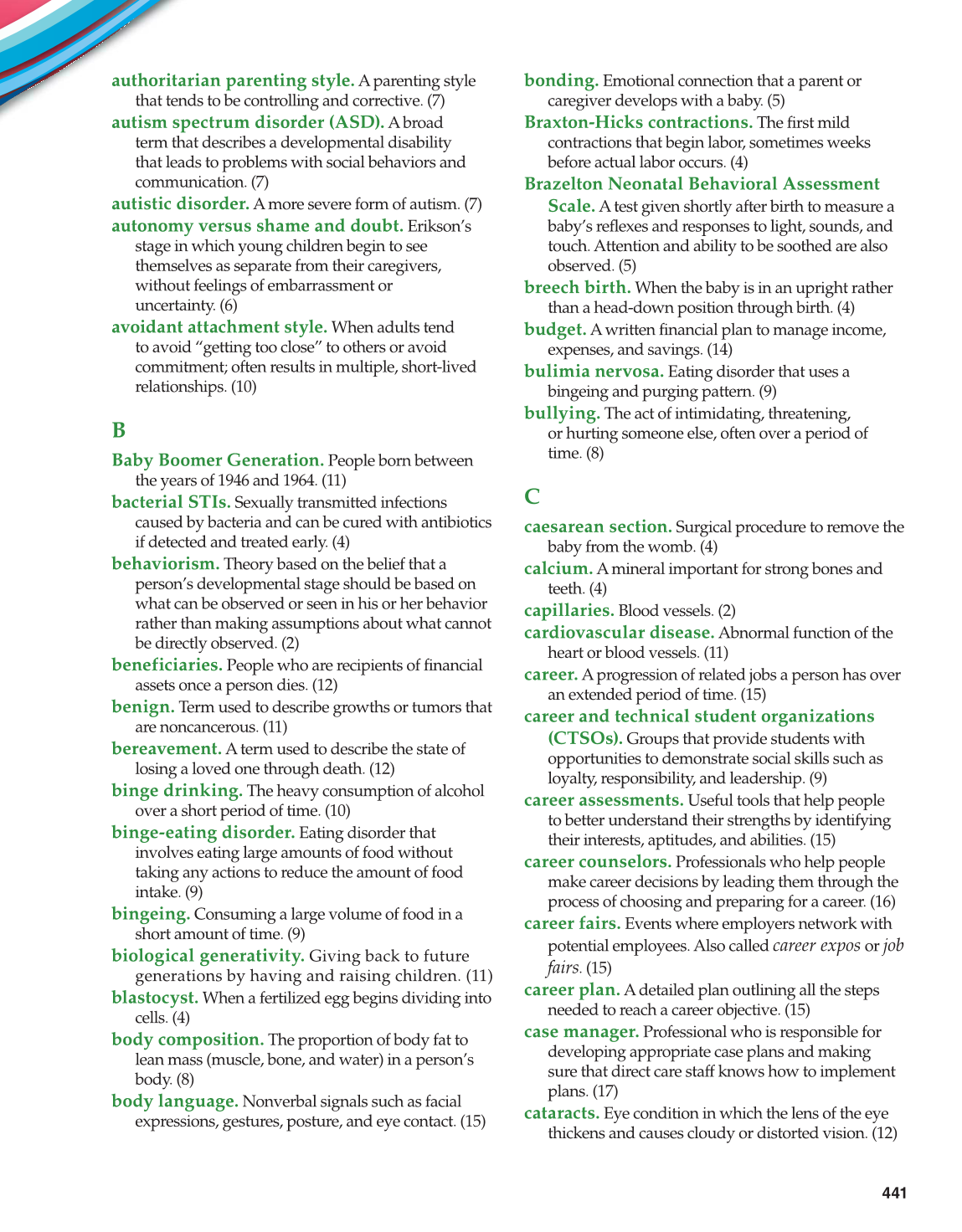441
authoritarian parenting style.
A parenting style
that tends to be controlling and corrective. (7)
autism spectrum disorder (ASD).
A broad
term that describes a developmental disability
that leads to problems with social behaviors and
communication. (7)
autistic disorder.
A more severe form of autism. (7)
autonomy versus shame and doubt.
Erikson’s
stage in which young children begin to see
themselves as separate from their caregivers,
without feelings of embarrassment or
uncertainty. (6)
avoidant attachment style.
When adults tend
to avoid “getting too close” to others or avoid
commitment; often results in multiple, short-lived
relationships. (10)
B
Baby Boomer Generation.
People born between
the years of 1946 and 1964. (11)
bacterial STIs.
Sexually transmitted infections
caused by bacteria and can be cured with antibiotics
if detected and treated early. (4)
behaviorism.
Theory based on the belief that a
person’s developmental stage should be based on
what can be observed or seen in his or her behavior
rather than making assumptions about what cannot
be directly observed. (2)
beneficiaries.
People who are recipients of financial
assets once a person dies. (12)
benign.
Term used to describe growths or tumors that
are noncancerous. (11)
bereavement.
A term used to describe the state of
losing a loved one through death. (12)
binge drinking.
The heavy consumption of alcohol
over a short period of time. (10)
binge-eating disorder.
Eating disorder that
involves eating large amounts of food without
taking any actions to reduce the amount of food
intake. (9)
bingeing.
Consuming a large volume of food in a
short amount of time. (9)
biological generativity.
Giving back to future
generations by having and raising children. (11)
blastocyst.
When a fertilized egg begins dividing into
cells. (4)
body composition.
The proportion of body fat to
lean mass (muscle, bone, and water) in a person’s
body. (8)
body language.
Nonverbal signals such as facial
expressions, gestures, posture, and eye contact. (15)
bonding.
Emotional connection that a parent or
caregiver develops with a baby. (5)
Braxton-Hicks contractions.
The first mild
contractions that begin labor, sometimes weeks
before actual labor occurs. (4)
Brazelton Neonatal Behavioral Assessment
Scale.
A test given shortly after birth to measure a
baby’s reflexes and responses to light, sounds, and
touch. Attention and ability to be soothed are also
observed. (5)
breech birth.
When the baby is in an upright rather
than a head-down position through birth. (4)
budget.
A written financial plan to manage income,
expenses, and savings. (14)
bulimia nervosa.
Eating disorder that uses a
bingeing and purging pattern. (9)
bullying.
The act of intimidating, threatening,
or hurting someone else, often over a period of
time. (8)
C
caesarean section.
Surgical procedure to remove the
baby from the womb. (4)
calcium.
A mineral important for strong bones and
teeth. (4)
capillaries.
Blood vessels. (2)
cardiovascular disease.
Abnormal function of the
heart or blood vessels. (11)
career.
A progression of related jobs a person has over
an extended period of time. (15)
career and technical student organizations
(CTSOs).
Groups that provide students with
opportunities to demonstrate social skills such as
loyalty, responsibility, and leadership. (9)
career assessments.
Useful tools that help people
to better understand their strengths by identifying
their interests, aptitudes, and abilities. (15)
career counselors.
Professionals who help people
make career decisions by leading them through the
process of choosing and preparing for a career. (16)
career fairs.
Events where employers network with
potential employees. Also called
career expos
or
job
fairs.
(15)
career plan.
A detailed plan outlining all the steps
needed to reach a career objective. (15)
case manager.
Professional who is responsible for
developing appropriate case plans and making
sure that direct care staff knows how to implement
plans. (17)
cataracts.
Eye condition in which the lens of the eye
thickens and causes cloudy or distorted vision. (12)
